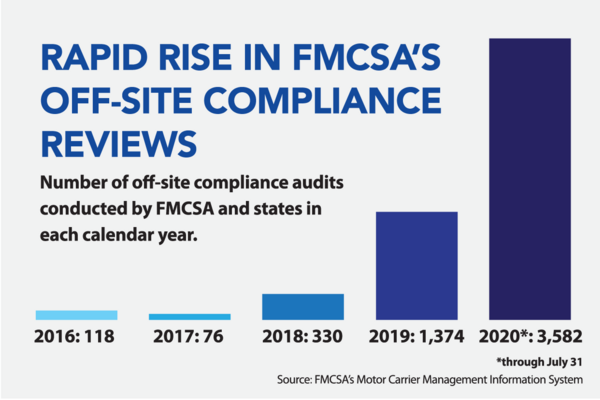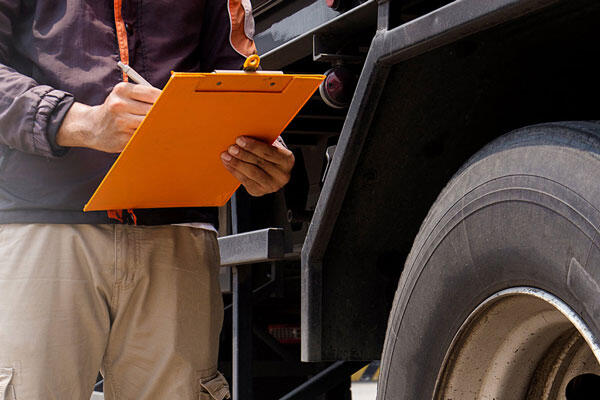The FMCSA has Contacted Me for a Compliance Review
The FMCSA has Contacted Me for a Compliance Review
If a motor carrier has been contacted by the Federal Motor Carrier Safety Administration (FMCSA) or their state motor carrier enforcement division about an audit or intervention, it is likely because their Compliance, Safety and Accountability (CSA) scores have crossed a threshold that the FMCSA now has the carrier on their radar. There are other reasons why audits occur, but the CSA score is the most common. There are a limited number of FMCSA enforcement officers, so they may contract with your state to use state carrier enforcement officers to conduct interventions and audits.
Other reasons why an audit of intervention could occur:
- A carrier is new to the industry (New Entrant)
- The FMCSA is following up after a conditional or unsatisfactory review
- A carrier has had a high-profile fatal accident or a spill of Hazardous Materials involving an accident
- A carrier asks for an audit
- Someone has filed a written complaint with the FMCSA about non-compliance of regulations regarding a motor carrier
How much notification do carriers receive in advance of a compliance review?
Carriers are notified by the Federal Motor Carrier Safety Administration typically with a written letter and generally given two weeks prior to the review. However, if they feel that the level of compliance or violations are serious, they can come in unannounced.
Prior to the start of the review
When they arrive at your place of business one of the first things you will ask them for, if they do not initially provide, is identification. Do not be reluctant in asking for this as all federal and state employees are required to have identification with them. You need to be sure that they are federal or state employees.
Be respectful. They are there to do a job. Set them up in a conference or meeting room that is away from the flow of other employees that is quiet. Offer them coffee, water, or soda as a beverage while they are working. Do NOT offer to buy lunch or provide any gratuities. Make sure the heat and air in the room is set to their liking.
Lastly, provide them with a preferred method of how to contact you during the audit. i.e., text, phone, etc.
As the person responsible for compliance with the regulations you will be there point of contact. I would recommend that all documentation requested be delivered by you.
At the end of the audit, they will want to talk to the owner or president of the company for the final review and to wet sign the audit findings. During the review of there findings is your opportunity to discuss with the officer the violations they have discovered. Do not be argumentative with the officer. If you do not agree with a violation, then ask them to explain how they arrived at the violation. They may have missed a piece of documentation that you need them to be aware of. Also, regulations can have different interpretations. Explain to them your interpretation of the regulation and discuss if there is a difference.
What must carriers produce for a review?
Prior to the audit the officer will do their homework on you the carrier and come in with documentation on your driver and vehicle information from the CSA program. They will know the drivers and the vehicles involved in violations, accidents and out of service violations and will likely request documentation related to those violations.
When providing requested documentation provide exactly what they are asking for and NO more. Far example if they request the hours-of-service documentation on a driver for 5 specified days of a month do NOT give them the entire month of documentation. If they are general in their request then see if you can pin them down to specific days.
These are some of the records that will be requested during a compliance review:
- Proof of financial responsibility (MSC-90 this is for carriers with for-hire authority only)
- Driver qualification and training files
- Drug and alcohol testing policy and records if applicable (CDL drivers only)
- Records of duty status (logs) and supporting documents.
- Inspection and maintenance files (this can include certification for technicians who repair brakes and conduct annual inspections)
- Hazardous materials records if applicable
- Accident registers and copies of accident reports.
- Medical certifications of drivers
What can a carrier expect during a review?
The officer will often begin the review by conducting a brief interview and asking carriers for a tour of the facility. The interview will consist of basic questions about the carrier’s operation and safety and driver training programs.
The process will then shift to reviewing documentation. Carriers should make a table or desk available for the investigator to use during the audit. The investigator will also need access to files, records, and other documentation important to the process. If your files are stored electronically, be prepared to display and/or print them. If you are an Idealease customer and you are notified of a review, contact your Idealease representative immediately so they can have your maintenance files ready at the officer’s request.
What should carriers do during the process?
The best advice for carriers during the audit process is to be helpful and remain calm. Carriers’ representatives should respond to all requests in a timely manner and be honest with the investigator.
Audits are a stressful time for companies. But panicking when first learning about the audit will only make the experience more difficult. If carriers have the proper management and safety procedures in place, they are on the right path to getting through an audit with success.
Top Audit Violations
The top violations discovered during reviews are included in A & I Online's yearly summaries.
The top five acute regulations in CY 2020 reflected DOT testing and CDL license violations:
Rank Violation
1 Allowing driver to drive with suspended/revoked/etc. CDL (383.37A)
2 Failing to implement an alcohol and/or drug testing program (382.115A)
3 Failing to implement random controlled substance or alcohol testing program (382.305)
4 Allowing driver with more than one CDL to drive a CMV (383.37B)
5 Failing to randomly test for drugs and/or alcohol (382.3052)
Noncompliance with a single acute regulation is considered a serious violation. Noncompliance is so severe that it requires immediate corrective actions by a motor carrier.
The top five critical regulations in CY 2020 included several violation types, with the top two violations falling under hours of service:
Rank Violation
1 Not using the appropriate method to record hours of service (395.8A1)
2 False reports of records-of-duty status (395.8E1)
3 Inquiries into driving record are not kept in DQ file (391.51B2)
4 Using a CMV that is not periodically inspected (396.17A)
5 Using a driver before receiving a pre-employment result (382.301A)
Critical regulations are identified as those where noncompliance relates to a breakdown in a carrier's management controls. A pattern of noncompliance will affect a carrier's safety rating.
A pattern of noncompliance is considered more than one violation. When several documents are reviewed, the number of violations required to meet a pattern of noncompliance is equal to at least ten percent of those examined.
FMCSA Releases Enforcement Data for 2020
A data snapshot of motor carrier violations occurring in Calendar Year (CY) 2020 was recently updated by Federal Motor Carrier Safety Administration's (FMCSA) Analysis & Information (A & I) Online to include the entire year.
A & I Online summarizes motor carrier and driver compliance on and off the road and commercial motor vehicle (CMV) crashes, as appearing in Motor Carrier Management Information System (MCMIS).
A & I Online captures MCMIS data and provides current year-to-date information, which is often incomplete for the current year. In late January 2021, A & I Online updated its data to reflect all available information on roadside inspections and investigations occurring in CY 2020.
Roadside Inspections
In CY 2020, 2,570,280 roadside inspections were performed. Of those inspections, approximately:
56 percent resulted in a violation, and
18 percent resulted in an out-of-service violation.
The top five driver violations cited during roadside inspections in CY 2020 were primarily based on driving behavior:
Rank Violation
1 Speeding 6-10 miles per hour over the speed limit (392.2SLLS2)
2 Failure to obey traffic control device (392.2C)
3 Failing to use seat belt while operating a CMV (392.16)
4 False report of drivers record-of-duty status (395.8E)
5 Lane restriction violation (392.2LV)
Often a traffic violation is the reason a CMV vehicle is stopped and then inspected.
The top five vehicle-related violations occurring during roadside inspections in CY 2020 include:
Rank Violation
1 Inoperable required lamp (393.9)
2 Operating a CMV without proof of a periodic inspection (396.17C)
3 Clamp or roto-type brake out-of-adjustment (393.47E)
4 No/discharged/unsecured fire extinguisher (393.95A)
5 Inspection, repair, and maintenance of parts and accessories (396.3A1)
Investigations
In CY 2020, offsite reviews were the most common review type (50.32%), followed by onsite focused reviews (31.45%), and onsite comprehensive (17.21%). Other inspection types (cargo tank facilities, shipper reviews, non-rated reviews) together accounted for approximately 1% of the remaining reviews.
In addition to reviews, federal and state enforcement performed 40,579 new entrant safety audits last year.









